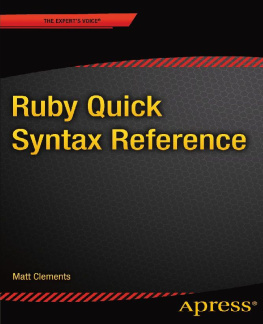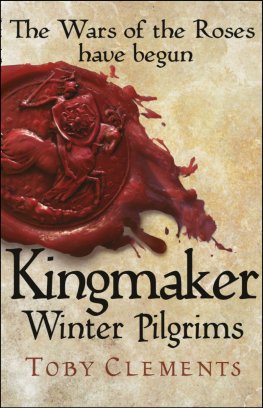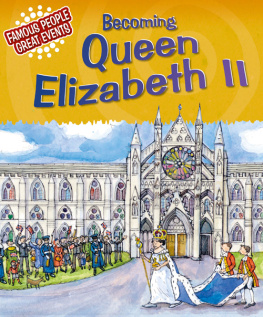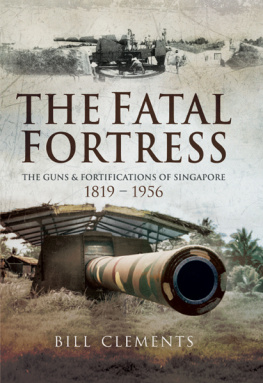Clements - Tombs of the Vanishing Indian
Here you can read online Clements - Tombs of the Vanishing Indian full text of the book (entire story) in english for free. Download pdf and epub, get meaning, cover and reviews about this ebook. City: California;Los Angeles;Los Angeles (Calif.);United States;Vancouver;B.C, year: 2012, publisher: Talonbooks, genre: Detective and thriller. Description of the work, (preface) as well as reviews are available. Best literature library LitArk.com created for fans of good reading and offers a wide selection of genres:
Romance novel
Science fiction
Adventure
Detective
Science
History
Home and family
Prose
Art
Politics
Computer
Non-fiction
Religion
Business
Children
Humor
Choose a favorite category and find really read worthwhile books. Enjoy immersion in the world of imagination, feel the emotions of the characters or learn something new for yourself, make an fascinating discovery.

- Book:Tombs of the Vanishing Indian
- Author:
- Publisher:Talonbooks
- Genre:
- Year:2012
- City:California;Los Angeles;Los Angeles (Calif.);United States;Vancouver;B.C
- Rating:5 / 5
- Favourites:Add to favourites
- Your mark:
- 100
- 1
- 2
- 3
- 4
- 5
Tombs of the Vanishing Indian: summary, description and annotation
We offer to read an annotation, description, summary or preface (depends on what the author of the book "Tombs of the Vanishing Indian" wrote himself). If you haven't found the necessary information about the book — write in the comments, we will try to find it.
Marie Clements powerful multimedia dramas address difficult Aboriginal issues with sharp insight and critique.
Tombs of the Vanishing Indian — read online for free the complete book (whole text) full work
Below is the text of the book, divided by pages. System saving the place of the last page read, allows you to conveniently read the book "Tombs of the Vanishing Indian" online for free, without having to search again every time where you left off. Put a bookmark, and you can go to the page where you finished reading at any time.
Font size:
Interval:
Bookmark:

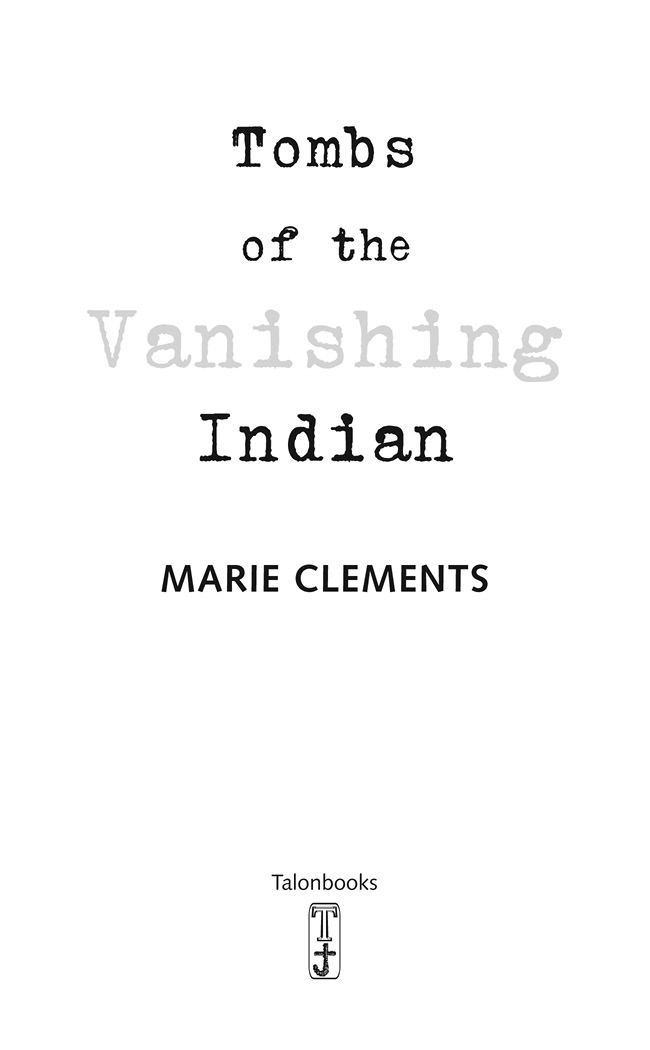 Copyright 2012 Marie Clements Talonbooks
Copyright 2012 Marie Clements Talonbooks
P.O. Box 2076, Vancouver, British Columbia, Canada V6B 3S3
www.talonbooks.com Typeset by Typesmith. Cover design by Overleaf. First printing: 2012 The publisher gratefully acknowledges the financial support of the Canada Council for the Arts; the Government of Canada through the Canada Book Fund; and the Province of British Columbia through the British Columbia Arts Council and the Book Publishing Tax Credit for our publishing activities. All rights reserved. No part of this book may be reproduced, stored in a retrieval system, or transmitted, in any form or by any means, without the prior written consent of the publisher or a licence from The Canadian Copyright Licensing Agency ( Access Copyright ) .
For a copyright licence, visit www.accesscopyright.ca or call toll free to 1-800-893-5777. Rights to produce Tombs of the Vanishing Indian , in whole or in part, in any medium by any group, amateur or professional, are retained by the author. Interested persons are requested to apply to her agent: Michael Petrasek, Kensington Literary Representation, 34 St. Andrew Street, Toronto, Ontario, Canada M5T 1K6 ;
Tel .: ( 416 ) 979-0187; email: kensingtonlit@rogers.com. Cataloguing data available from Library and Archives Canada ISBN 978-0-88922-713-2 PRODUCTION HISTORY Tombs of the Vanishing Indian was commissioned to mark the tenth anniversary of the Native Voices series at the Autry National Center and the Southwest Museum of the American Indian in Los Angeles. Given an extended research and writers retreat and workshop at Native Voices in 2004 and 2005, Tombs of the Vanishing Indian was presented as a staged reading in November 2005 at Live at the Autry in Los Angeles.
Additional staged readings were performed at La Jolla Playhouse on Saturday, June 5, and at the Autry National Center on Saturday, June 26, 2010. Director : Seema Sueko Dramaturg : Brian Quirt Tombs of the Vanishing Indian was first performed in a Native Earth Performing Arts and red diva p rojects co-production at Buddies in Bad Times Theatre in Toronto from March 9 to March 27, 2011. JESSIE : Nicole Joy-Fraser MIRANDA : Falen Johnson JANEY : PJ Prudat THE MOTHER / The Lone Woman / Ruth / Sarah :
Michelle St. John DR . DANIEL HANSEN / BLACKCOAT THREE :
Keith Barker BOB STILLS / BLACKCOAT TWO / WHITE INTERN ONE :
David Storch DETECTIVE FULLEN / BLACKCOAT ONE / WHITE INTERN TWO : Martin Julien Director : Yvette Nolan Set Design : Jackie Chau Composer : Jennifer Kreisberg Gabrielino Translation and Language Coach : Virginia Carmelo INTRODUCTION Tombs of the Vanishing Indian is a work on the cusp. It balances on edges keener than a straight razor and, like the imagery of water and tears the play paints, it rushes at us in a torrent.
It is at its inception already a canonical work. Tombs of the Vanishing Indian lives in between spaces, between our intellect and our emotions, working its way past our constructs and reasoning deeply into our bones. It is a play that upon first reading already insinuates itself along the pathways of our nerves, as it drives itself relentlessly towards the harrowing conclusions that its characters must inevitably face. There is no place for us to escape its breakneck velocity. In its first scene, this dominant theme emerges flight. Characters running for their lives.
The sound of feet running from certain danger. Flashlights. Darkness. And blood mixed with water. Just as in her earlier work, playwright Marie Clements carves theatrical space to her will. Three sisters.
Three spaces. Three glass rooms. Dioramas. Glass cages. Clements, like a surgeon, opens American history unflinchingly. In the life of one family, we see the displacement of communities, the legacy of Indian boarding schools and missions, and finally the forced sterilization programs run by the Indian Health Service and the Bureau of Indian Affairs in the 1950s and 1970s.
Andrea Smith, in her 2005 book Conquest , examines this attack on women and the governments use of sexual violence as a tool of genocide. Native women were targeted precisely because their ability to reproduce continued to [stand] in the way of the [ongoing] conquest of Native lands ( p. 79 ) . In her use of theatrical space, Clements helps us understand that these womens bodies these vital spaces are in fact another battlefront for the continuing wars of Manifest Destiny and control. From the pages of Tombs of the Vanishing Indian , the land literally leaps out at the reader, guiding us into knowledge and situating us not so much in a darkened theatre in a northern city but in the deserts of the West. Commissioned in 2003 by Native Voices at the Autry and developed in association with them at the Native Voices at the Autry Playwrights Retreat in Los Angeles in 2004 and 2005, the work is an extension of that community and its sun-drenched landscapes.
Even the language of the land emerges rightfully in Clementss writing. The Gabrielino dialect, brought powerfully into play by the ghost of the three sisters mother, evokes much more than the culture from which the daughters were taken. It becomes the music of the play, a threnody for an entire generation. But it is easy to look at this use of language in terms of loss of culture which of the sisters learn it, speak it, once they are cut away from the source? In Tombs of the Vanishing Indian , the use of Gabrielino is far more complex. Again, it is one of the means the playwright uses to slip into the in-between spaces of her characters lives, into the spaces Clements always leaves for her actors to discover. Gabrielino, in the scenes with Detective Fullen, in particular, becomes a shield which The Mothers ghost uses to protect the daughters from the deafening crash of cultures.
The Mother says, Keep me inside of you. The language is what is inside of them, a gift from their mother, and, in theatrical terms, it is the vehicle through which we see their bond come alive onstage. Of course, Los Angeles, where the play is set, is diverse. Spanish mixes easily with Gabrielino. And the life of the three sisters mixes inevitably with that other culture: Hollywood. Clements delights in opening up the wounds brought about by Hollywoods history, which many indigenous scholars have also explored in recent years.
Much of the plays ironic humour emerges from this intersection. Miranda, one of the sisters, remarks to a hack film director, you wouldnt know dark and mysterious if it licked your behind. Half of the scholarship about Indians on film h as just been boiled down to one gleeful sentence. Clementss potent work will naturally draw comparisons to another play about three sisters. And, yes, there are a few similarities exquisitely drawn characters, compromised situations, and women searching for something better, but this play is written from the trenches, from the other side of the tracks. It is a clarion cry to rid ourselves of false consciousness and to turn ourselves towards the oncoming flood.
This play brings painful knowledge about our collective past but gives us warning to root ourselves in it to find the shields still embedded therein or risk being washed away by the deluge. MICHAEL GREYEYES THE LONE WOMAN Seventy miles off the coast of Los Angeles lies San Nicolas Island, once inhabited by Gabrielino-Tongva Indians. In 1835, a ship arrived to gather the last surviving Indians living there to take them to Santa Barbara Mission on the mainland. As the ship arrived, a huge storm developed. Fearing the ship was in danger, the captain hurried the Indians on board. As the ship began to sail, a young Indian mother looked for her baby, who she thought a relative had carried aboard.
Next pageFont size:
Interval:
Bookmark:
Similar books «Tombs of the Vanishing Indian»
Look at similar books to Tombs of the Vanishing Indian. We have selected literature similar in name and meaning in the hope of providing readers with more options to find new, interesting, not yet read works.
Discussion, reviews of the book Tombs of the Vanishing Indian and just readers' own opinions. Leave your comments, write what you think about the work, its meaning or the main characters. Specify what exactly you liked and what you didn't like, and why you think so.


